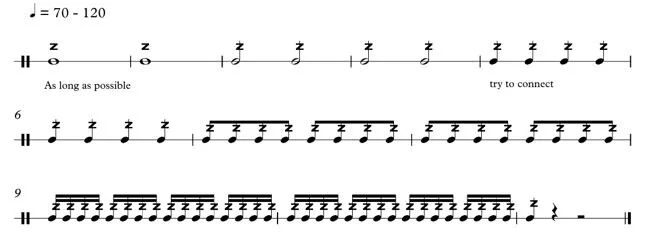We are onto the second post of Percussion Talk! Thank you so much for the warm reception and helpful feedback on the first post. It was great to hear from so many people from such diverse backgrounds. As you make it through your week, let me know if you have something you’d like to see covered in a future post! It doesn’t have to be today or tomorrow, but keep this blog in mind as you are teaching your percussionists this week. Also, make it to the end of this post for a post-halloween surprise! Have a percussion issue you just can’t figure out? Leave a comment below!
Snare Drum Fundamentals Pt. 2
Two of the things that many music educators struggle with are stroke type and how to develop great multiple bounces that eventually lead to a great buzz roll. Below are some descriptions and helpful exercises that will help!
Snare Drum Single Stroke Fundamentals
Not including multiple bounce or double strokes, there are FOUR types of single strokes on snare drum. They are defined by where they start the stroke, and where they end the stroke. All strokes either start up or down and end up or down. All single strokes are primarily played with WRIST.
Developing Great Multiple Bounces
Many music educators find creating a good, consistent multiple bounce stroke (buzz) to be one of the most difficult things to teach a young percussionist. At its core, you are trying to teach someone how to sustain on an instrument that doesn’t naturally sustain! Here’s the easy way how to teach someone how to play a buzz:
Loose back fingers*
Downward Pressure
Firm Grip Point
Use Primarily Arm
*I find this to be the number one reason students struggle creating a consistent multiple bounce stroke.
Try these three exercises to help you get going with your bounce strokes:
Exercise 1 – Beginning Buzzes
This is the exercise I use after the student understands how to create a multiple bounce and is trying to develop long and consistent buzzes. Listen for even hands and try to connect each note to the next!
Exercise 2 – Buzz Build Up
This is where you start to develop a great buzz roll. Similar to the previous exercise, each buzz should try to connect to the next note before it ends. If it doesn’t quite make it, that’s OK!
Exercise 3 – Buzz Grid
I’ve found that many times the key to creating good even buzzes is to practice them uneven! Keep the unaccented notes low to the drum while trying to make each individual buzz as long as possible.
If you have made it this far, thank you for reading! If your percussionists work on these exercises and you find them useful, let me know! You can find me on twitter, instagram (dog pics, coffee, percussion education), and facebook. Here’s a sneak peak of the dog pics you may find on my instagram. See you next time!
Our two dogs, Pumpkin and Ellie. Yes, Pumpkin dressed as a pumpkin for halloween.





